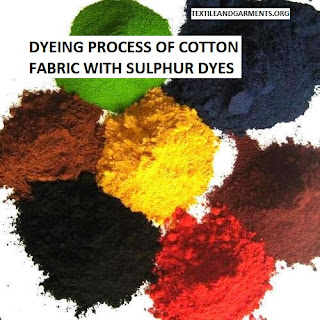Dyeing Process of Cotton Fabric With Sulphur Dyes
Dyeing Process of Cotton Fabric With Sulphur Dyes
Sulphur Dyes
Sulphur dyes are highly colored, water-insoluble compounds and have to be converted into Water Soluble substantive forms before application to the textile materials. This conversion is carried out by a treatment with a reducing agent like dilute aqueous Na2S.
Apparatus Required for Dyeing
- Beaker
- Glass Rod
- Cylinder
- Electric Balance
- Thermometer
- Dryer
100 % cotton knitted fabric
Objectives of Sulphur Dyeing:
- To learn about how to cotton fabric dyeing with sulphur dyes
- To know about sulphur dyes
- To get an idea about the function of used dyeing chemicals
- To know how to improve the dyeing process
Function of Used Dyeing Chemicals
Sequestering Agent- To remove the hardness from water
Alkali - It converts oil into water-soluble fatty acid and soap
Salt - It acts as a catalyst that accelerates absorption rate and reduces surface tension.
Hydrose - It acts as a reducing agent
H2O2 - It helps to insoluble the sulfur dyes
Acetic acid - Helps to keep the solution in an acidic medium to react with dye and fabric
Shade - Provides the desired color.
Working Procedure:
Reduction
The dye was taken in a vessel and mixed well with alkali and added specific amount of water. Specific amount of soda ash is added to neutralize any acid formed in the dyestuff during storage. The quantity of reducing agent depends upon the shade depth and M:L of the bath.
Dyeing
The dye is kept ready with small quantity of the alkali stable and compatible wetting agent, a dye bath stabilizer, sodium sulphide and caustic soda. The dye is then added to the solution after (15-25) minutes. The temperature is then raised to above 180 C and kept above the heater enough time
Oxidation
The oxidation is done to reconvert the leuco compound back to insoluble dye.
Dyeing Recipe:
1. Reduction:
Sequestering agent - 1cc/L
Hydrose - 3gm/L
NaOH - 3 gm/L
pH- 11
Temperature - 60 C
Time- 10min
Dyes - 1% (o.w.f)
M:L - 1: 70
2. Dyeing
Salt - 15 gm/L
Time - 20 min
Temperature - 80 C
3. Oxidation
Sequestering agent - 1cc /L
Acetic acid - 2cc/L
H2O2 - 3cc/L
pH - (4.5-5.5)
Temperature - 80 C
Time - 10 min
M: L - 1:60
Calculation:
Fabric weight = 3.65gm
Weight of water = 3.65*70 (M:L ratio) = 260cc/L
Hydrose = 3*260/1000 = 0.78 gm
NaOH = 3*260/1000 = 0.78gm
Sequestering agent = 1*260 /1000 = 0.26cc/L
Dyes = 1*3.65 /100 (o.w.f) = 0.0.37 gm
Salt = 15*260/1000 = 3.9 gm
Sequestering agent = 3.65*60 (M:L ratio) = 219/1000 = 0.219cc/L
Acetic acid = 2*219/1000 = 0.438 cc/L
H2O2 = 3*219/1000 = 0.657 cc/L
Conclusion:
From this experiment, we can learn how to dye cotton fabric with sulphur dyes which will helps in our future practical dyeing job life.




Comments
Post a Comment